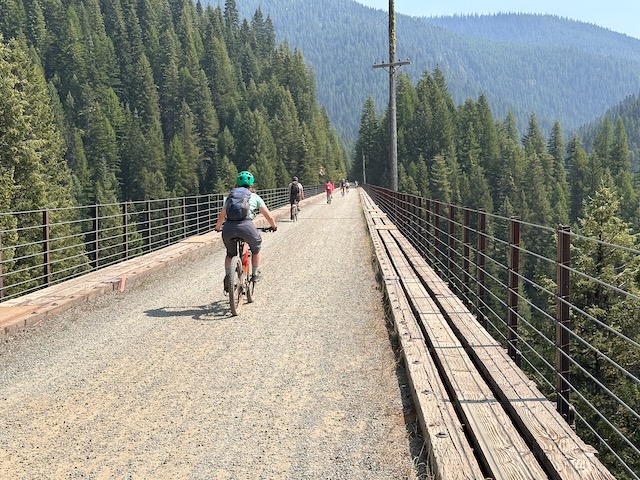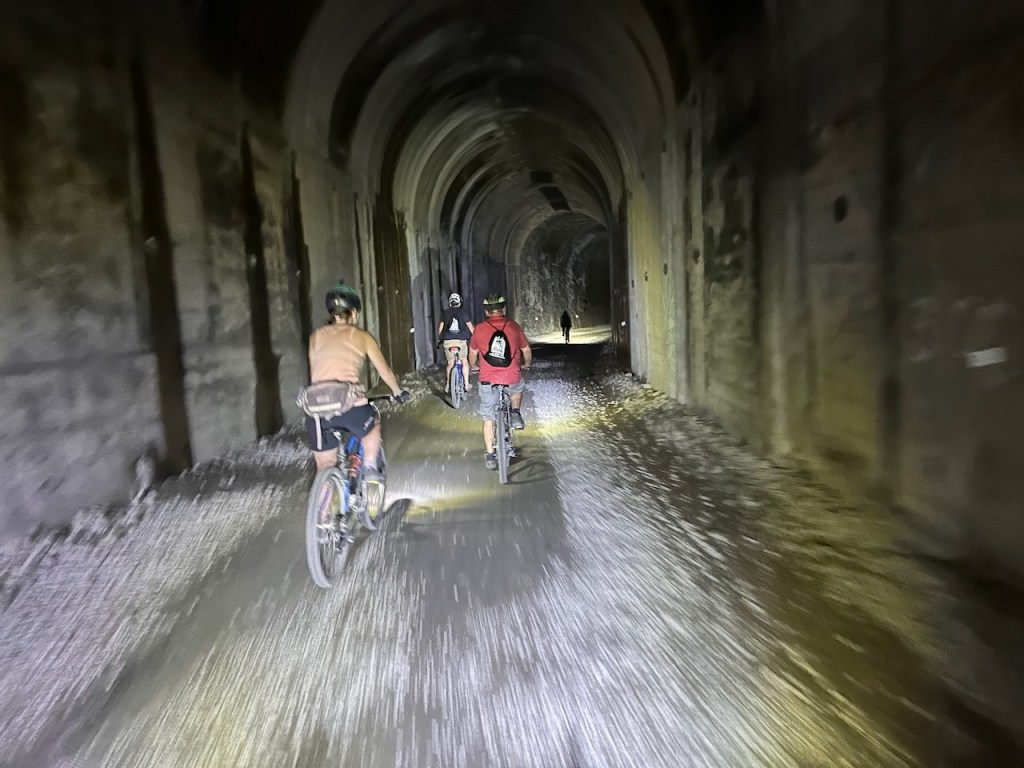Our last day of riding in Idaho was also our most southerly and easterly ride of the trip. Our destination for the day was, technically, Montana, where we would begin a ride on the Route of the Hiawatha. Often called the crown jewel of the rail-trail movement, the Route of the Hiawatha is a 15 mile descent from Montana, south into Idaho.
The Route of the Hiawatha is named for the Olympian Hiawatha, the train line that ran from Chicago to Seattle. The trail features an ultra-gentle 2-3 percent grade, a fine-crushed gravel surface perfect for gravel bikes, 10 tunnels and views that will restore anyone’s sense of wonder when confronted with such natural beauty.

For reasons of time and logistics, we were unable to ride both down and back. This was one time when I’d feel guilty about the shuttle. Also, due to time and logistics I was unable to ride my gravel bike, which had been my intention (as was riding back up). Fortunately, with a gentle grade and smooth surface, riding my mountain bike with a blown fork seal posed no issues.
When I looked up the destinations in our itnerary and found the site for the Route of the Hiawatha, my first thought was how much it reminded me of the Palouse to Cascades rail trail outside of Seattle. The views along the Palouse to Cascades take in craggy peaks, the occasional waterfall and breathtaking expanses of air beneath trestle bridges. But it does suffer one minor inconvenience. I-90 runs below the Palouse to Cascades, with the constant white noise roar of the highway filtering up to riders.
The Route of the Hiawatha is as middle-of-nowhere as I’ve experienced. Without the old rail line, it doesn’t seem we would have seen anything manmade. A haze hung in the air due to a nearby fire, but even that didn’t ruin the views.

The rail trail gave us an intimate view of pristine forest—too bad all the old-growth trees have been cut. Our guide for the day, Matt Sawyer (pictured below), marketing director for Route of the Hiawatha, told us that when loggers first entered the area, some of the trees were more than 16 feet across at their base; I had to hear him say that a second time before I was convinced I’d heard correctly. I tried to visualize what a forest of giants like that would look like, the incredible distance that would exist between trees due to their size, not to mention how dangerous it must have been to cut down trees that large. Sawyer knows the history of the trail, and the area, thoroughly and has the ability to paint a vivid portrait of the rough-and-tumble lives that people led at the beginning of the last century, including of the devastating fire of 1910 that took out the old growth trees the loggers hadn’t yet cut. Somewhere between 2.5 and 3 million acres burned. Every tree we saw began growing after that fire.
Upon reaching the bottom of the descent, we did like 99 percent of the other tourists, and hopped in an old school bus to be shuttled back to the top. Honestly, I found that fun—hanging out, talking about what we’d just experienced.

The PR game
I get that the ride lacks drama or any semblance of rad, but the ride gave us several welcome features. First, I was tired and sore. We would have benefitted to doing the Route of the Hiawatha on day 3, rather than day 4, but it was welcome nonetheless. This was the first time where it was possible to both ride and have a conversation and that gave us all a chance to get to know each other better. This was also the first day we got to ride with Tony, the PR person who had arranged our itinerary. Tony’s a delightful guy, an easy conversationalist and as a native of Idaho, his love of the place is so genuine that I never felt like I was being sold something. He simply delights in sharing Idaho with other people. That kind of earnest engagement isn’t something a PR company can buy.
I’ve once did a destination trip led by a PR rep so bent on impressing us with the best food and drink that the experience began to feel slimy. I could tell they were expecting effusive posts with a carney barker’s ability to capture a crowd. I wrote what I wrote, but it was uncomfortable and I told myself that I wouldn’t do a trip like that again. It’s hard to say what was different about Ski Idaho, but Tony presented as someone who is trying to get the word out that Idaho has world-class recreation and whether it’s a couple’s getaway or a family vacation, Idaho offers a chance to spend less without sacrificing enjoyment.
That’s a message worth getting out.

The highs and lows
I can recommend the Humbird at Schweitzer Resort without reserve. That was easily the nicest room of our trip. While the Silver Mountain Resort wasn’t as fancy, it’s the sort of place where a family can afford to book two rooms. The Wallace Inn was decidedly rough around the edges; I found a potato chip and a Skittle (singular) in my room.
Most of our food was great. The real standout of the trip was Matchwood Brewing in Sandpoint. The spicy chicken sandwich (with bacon) was perfect after a day of mountain biking. I washed it down with Illegal Smile, a West Coast IPA, and Attractive Nuisance, a hazy IPA. I’m going to cop to being spoiled by all the great breweries in Sonoma County. I can be hard to impress, though I endeavor not to be a snob. Those two IPAs were easily the best beers of the trip; hell, they are the best IPAs I’ve had that weren’t produced in California, Oregon or Washington. Sorry Dogfish Head.
Flights to Spokane tend to run cheap, especially on Alaska Airlines. Silver Mountain Resort was so family friendly I could see taking my sons there on vacation. I don’t see them riding the mountain, but I could easily see them spending an afternoon at the indoor water park.

I’m cheap when it comes to travel. I rarely splurge for the nice room. I might do a nicer dinner one night, but generally I’m looking to conserve my spending for the fun stuff, like lift passes. Given what a one-day lift pass can run for Alpine skiing, the prices at Schweitzer and Silver were bargains. And with Lower Basin being free, you just need to figure out how to shuttle it, or allow time for the climb back to the top. It’s handy that you can ride the road to try to knock the climb out quickly.
To ride the Route of the Hiawatha, you purchase a day pass at the nearby ski area, Lookout Pass. On peak days (Friday, Saturday and Sunday), a pass goes for $36 for adults and $24 for kids. Midweek, it’s half that. A pass includes the shuttle; Lookout Pass rents bikes; they are modest performers, but the demands of the trail are also modest.
As Jennifer and I drove back to Coeur d’Alene (I almost say it right now), we commented on how easy the drive had been from Seattle. There are plenty of destinations within Washington that require a five-hour (or more) drive. Suddenly, Idaho became a candidate for a three-day weekend.
I hear the Nordic skiing is amazing.
Final image courtesy Tony Harrison
Patrick’s food, lodging and lift passes provided by Ski Idaho


